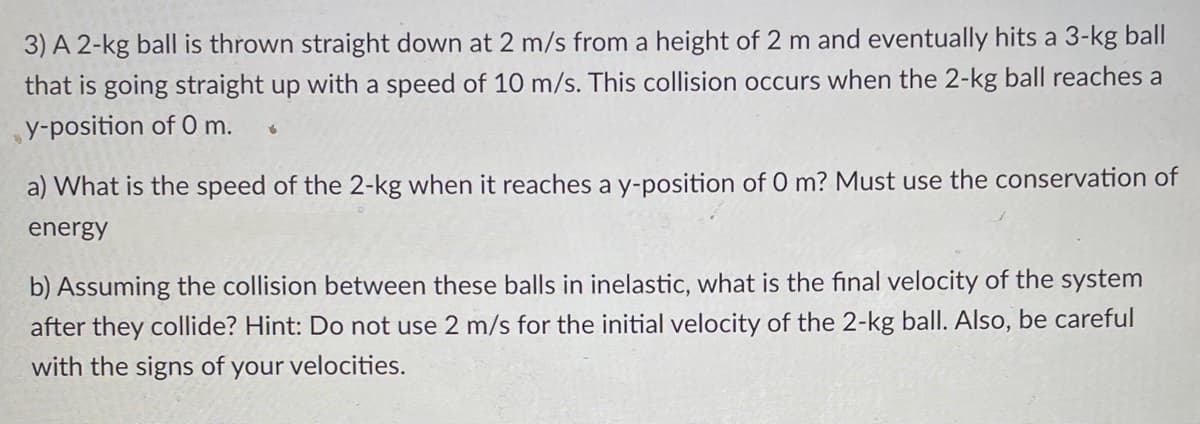3) A 2-kg ball is thrown straight down at 2 m/s from a height of 2 m and eventually hits a 3-kg ball that is going straight up with a speed of 10 m/s. This collision occurs when the 2-kg ball reaches a y-position of 0 m. a) What is the speed of the 2-kg when it reaches a y-position of 0 m? Must use the conservation of energy b) Assuming the collision between these balls in inelastic, what is the final velocity of the system after they collide? Hint: Do not use 2 m/s for the initial velocity of the 2-kg ball. Also, be careful with the signs of your velocities.
3) A 2-kg ball is thrown straight down at 2 m/s from a height of 2 m and eventually hits a 3-kg ball that is going straight up with a speed of 10 m/s. This collision occurs when the 2-kg ball reaches a y-position of 0 m. a) What is the speed of the 2-kg when it reaches a y-position of 0 m? Must use the conservation of energy b) Assuming the collision between these balls in inelastic, what is the final velocity of the system after they collide? Hint: Do not use 2 m/s for the initial velocity of the 2-kg ball. Also, be careful with the signs of your velocities.
Physics for Scientists and Engineers, Technology Update (No access codes included)
9th Edition
ISBN:9781305116399
Author:Raymond A. Serway, John W. Jewett
Publisher:Raymond A. Serway, John W. Jewett
Chapter9: Linear Momentum And Collisions
Section: Chapter Questions
Problem 9.41P: A billiard ball moving at 5.00 m/s strikes a stationary ball of the same mass. After the collision,...
Related questions
Question
Please help I’m confused, show detail in step by step manner and mention formula and units used. Thanks

Transcribed Image Text:3) A 2-kg ball is thrown straight down at 2 m/s from a height of 2 m and eventually hits a 3-kg ball
that is going straight up with a speed of 10 m/s. This collision occurs when the 2-kg ball reaches a
y-position of 0 m.
a) What is the speed of the 2-kg when it reaches a y-position of 0 m? Must use the conservation of
energy
b) Assuming the collision between these balls in inelastic, what is the final velocity of the system
after they collide? Hint: Do not use 2 m/s for the initial velocity of the 2-kg ball. Also, be careful
with the signs of your velocities.
Expert Solution
This question has been solved!
Explore an expertly crafted, step-by-step solution for a thorough understanding of key concepts.
This is a popular solution!
Trending now
This is a popular solution!
Step by step
Solved in 3 steps

Knowledge Booster
Learn more about
Need a deep-dive on the concept behind this application? Look no further. Learn more about this topic, physics and related others by exploring similar questions and additional content below.Recommended textbooks for you

Physics for Scientists and Engineers, Technology …
Physics
ISBN:
9781305116399
Author:
Raymond A. Serway, John W. Jewett
Publisher:
Cengage Learning

University Physics Volume 1
Physics
ISBN:
9781938168277
Author:
William Moebs, Samuel J. Ling, Jeff Sanny
Publisher:
OpenStax - Rice University

College Physics
Physics
ISBN:
9781305952300
Author:
Raymond A. Serway, Chris Vuille
Publisher:
Cengage Learning

Physics for Scientists and Engineers, Technology …
Physics
ISBN:
9781305116399
Author:
Raymond A. Serway, John W. Jewett
Publisher:
Cengage Learning

University Physics Volume 1
Physics
ISBN:
9781938168277
Author:
William Moebs, Samuel J. Ling, Jeff Sanny
Publisher:
OpenStax - Rice University

College Physics
Physics
ISBN:
9781305952300
Author:
Raymond A. Serway, Chris Vuille
Publisher:
Cengage Learning

College Physics
Physics
ISBN:
9781938168000
Author:
Paul Peter Urone, Roger Hinrichs
Publisher:
OpenStax College


Glencoe Physics: Principles and Problems, Student…
Physics
ISBN:
9780078807213
Author:
Paul W. Zitzewitz
Publisher:
Glencoe/McGraw-Hill